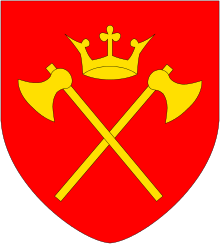Eidfjord
| Eidfjord kommune | |||
|---|---|---|---|
| Municipality | |||
|
View of the Måbødalen valley | |||
| |||
 Eidfjord within Hordaland | |||
| Coordinates: 60°26′06″N 07°16′38″E / 60.43500°N 7.27722°ECoordinates: 60°26′06″N 07°16′38″E / 60.43500°N 7.27722°E | |||
| Country | Norway | ||
| County | Hordaland | ||
| District | Hardanger | ||
| Administrative centre | Eidfjord | ||
| Government | |||
| • Mayor (2007) | Anved Johan Tveit (Sp) | ||
| Area | |||
| • Total | 1,491.47 km2 (575.86 sq mi) | ||
| • Land | 1,387.31 km2 (535.64 sq mi) | ||
| • Water | 104.16 km2 (40.22 sq mi) | ||
| Area rank | 53 in Norway | ||
| Population (2014) | |||
| • Total | 950 | ||
| • Rank | 406 in Norway | ||
| • Density | 0.68/km2 (1.8/sq mi) | ||
| • Change (10 years) | 3.7 % | ||
| Demonym(s) | Eidfjøre[1] | ||
| Time zone | CET (UTC+1) | ||
| • Summer (DST) | CEST (UTC+2) | ||
| ISO 3166 code | NO-1232 | ||
| Official language form | Nynorsk | ||
| Website |
www | ||
|
| |||
Eidfjord is a municipality in Hordaland county, Norway. The municipality is located in the traditional district of Hardanger. The administrative centre of the municipality is the village of Eidfjord, where the majority of the municipal population lives. The other major population centre in the municipality is the village of Øvre Eidfjord.
Eidfjord is situated at the end of the Eidfjorden, an inner branch of the large Hardangerfjorden. The village of Eidfjord is a major cruise ship port of call. Eidfjord has several tourist sites, like the Sima Power Plant which is built into the mountain itself, the Måbødalen valley, and the Vøringsfossen waterfall which has a free fall of 182 metres (597 ft). Large parts of the Hardangervidda (Europe's largest mountain plateau) are located in Eidfjord. The Hardangervidda Natursenter, a visitors centre and museum for Hardangervidda National Park, is located in Øvre Eidfjord.
General information


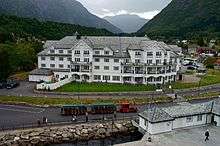
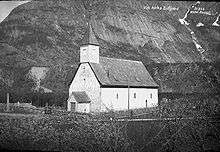
The parish of Graven (later spelled "Granvin") was established as a municipality on 1 January 1838 (see formannskapsdistrikt). This large municipality/parish included two annexes: Ulvik and Eidfjord. On 1 January 1859, Ulvik became the main parish, making Granvin and Eidfjord annexes to Ulvik, and the name of the large municipality was changed from Granvin to Ulvik.
On 1 May 1891, the eastern annex of Graven (population: 1,331) and the southeastern annex of Eidfjord (population: 1,018) were separated from Ulvik to become separate municipalities, leaving Ulvik as a much smaller municipality. In 1895, a small part of Eidfjord (population: 3) was transferred to Ulvik.
Eidfjord existed as a municipality from 1891 until 1964 when a major municipal merger took place as a result of municipal reform in Norway due to the Schei Committee. The municipality of Eidfjord (population: 983), most of the municipality of Kinsarvik (population: 1,513), and the municipality of Ullensvang (population: 2,358) were all merged into one large municipality that was named Ullensvang. This merger was not well-liked by the population of Eidsfjord, and so on 1 January 1977, part of the merger was undone, and the area of the "old" Eidfjord municipality (population: 1,223) was separated to form its own municipality once again.[2][3]
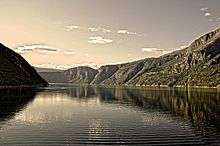
Name
The municipality is named after the Eidfjorden (Old Norse: Eiðafjörðr). The first element is the genitive case of the name of the old Eiðar farm (present-day Eidfjord) which has been the site of the Old Eidfjord Church since the 1300s. The second element is fjord. The name of the farm is the plural form of eið which means "land between two waters" (in this case: the fjord and the lake of Eidfjordvatnet).[2][4]
Coat-of-arms
The coat-of-arms is from modern times; they were granted on 13 July 1984. The arms are blue with a silver reindeer antler on the center. The reindeer antler was chosen because the first known settlers of the area were reindeer hunters. The reindeer has been of importance for the population in the Hardangervidda area for many centuries. The antler also symbolizes the rivers that run from the mountain into the fjord.[5]
Churches
The Church of Norway has one parish (sokn) within the municipality of Eidfjord. It is part of the Hardanger og Voss deanery in the Diocese of Bjørgvin.
| Parish (Sokn) | Church Name | Location of the Church | Year Built |
|---|---|---|---|
| Eidfjord | Eidfjord Church | Eidfjord | 1981 |
| Old Eidfjord Church | Eidfjord | 1309 |
Geography
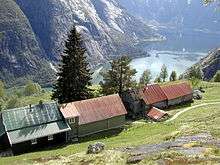
Eidfjord municipality sits at the innermost part of the Hardangerfjorden and it stretches inland to include part of the vast Hardangervidda plateau. Part of the Hardangervidda National Park lies in the municipality. Eidfjord municipality borders the municipality of Ullensvang to the southwest, the municipalities of Nore og Uvdal and Hol (both in Buskerud county) to the east, and the municipality of Ulvik to the north.
Eidfjord municipality begins at sea level along the fjord, the valleys leading away from the fjord are surrounded by high mountains which lead up to the alpine plateau called Hardangervidda. The Måbødalen valley is a narrow, picturesque valley that leads upland to the Vøringfossen waterfall, one of Norway's more famous waterfalls. There are several lakes in Eidfjord including Eidfjordvatnet, Nordmannslågen, and Sysenvatnet. The lakes Halnefjorden, Skaupsjøen, and Tinnhølen are all partially located in Eidfjord. The Hardangerjøkulen glacier is partially located in northern Eidfjord.
History
| Historical population | ||
|---|---|---|
| Year | Pop. | ±% |
| 1769 | 466 | — |
| 1801 | 547 | +17.4% |
| 1865 | 898 | +64.2% |
| 1900 | 861 | −4.1% |
| 1930 | 1,139 | +32.3% |
| 1951 | 1,126 | −1.1% |
| 1960 | 1,015 | −9.9% |
| 1970 | ** | — |
| 1980 | 1,208 | — |
| 1990 | 1,070 | −11.4% |
| 2000 | 1,037 | −3.1% |
| 2010 | 958 | −7.6% |
| 2014 | 950 | −0.8% |
| Sources: Statistics Norway 1951-present Statistics Norway 1769-1950. **Note: Eidfjord was merged into Ullensvang from 1964-1977. | ||
The parish of Eidfjord was very special because it belonged to the Bishop of Stavanger (and not the Bishop of Bergen as all the other parishes in Hordaland county) from 1125 until 1630. The Ancient Diocese of Stavanger was created out of the Ancient Diocese of Bergen and it included all of present-day Rogaland, Vest-Agder, and Aust-Agder counties, plus the districts of Hallingdal in Buskerud county and Valdres in Oppland county, and the parishes of Røldal and Eidfjord in Hordaland county. The reason for including Eidfjord was that the regions of Hallingdal and Valdres belonged to the bishop of Stavanger and the easiest way to reach them from Stavanger was by sailing up the Hardangerfjord to Eidfjord, and then traveling over the Hardangervidda plateau to Hallingdal and Valdres.
Government
All municipalities in Norway, including Eidfjord, are responsible for primary education (through 10th grade), outpatient health services, senior citizen services, unemployment and other social services, zoning, economic development, and municipal roads. The municipality is governed by a municipal council of elected representatives, which in turn elect a mayor.
Municipal council
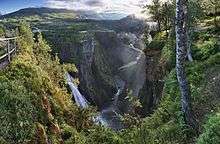
The municipal council (Kommunestyre) of Eidfjord is made up of 17 representatives that are elected to every four years. For 2011–2015, the party breakdown is as follows:[6]
| Party Name | Name in Norwegian | Number of representatives | |
|---|---|---|---|
| Labour Party | Arbeiderpartiet | 5 | |
| Conservative Party | Høgre | 3 | |
| Centre Party | Senterpartiet | 7 | |
| Liberal Party | Venstre | 1 | |
| Local Lists | Lokale lister | 1 | |
| Total number of members: | 17 | ||
See also
- Fossli Provincial Park, British Columbia, Canada (named after a village in Eidfjord)
References
- ↑ "Navn på steder og personer: Innbyggjarnamn" (in Norwegian). Språkrådet. Retrieved 2015-12-01.
- 1 2 Brekke, Nils Georg; Skaar, Ronny B; Nord, Svein (1993). Kulturhistorisk Vegbok Hordaland. Nord4.
- ↑ Jukvam, Dag (1999). "Historisk oversikt over endringer i kommune- og fylkesinndelingen" (PDF) (in Norwegian). Statistisk sentralbyrå.
- ↑ Rygh, Oluf (1919). Norske gaardnavne: Nordre Bergenhus amt (in Norwegian) (12 ed.). Kristiania, Norge: W. C. Fabritius & sønners bogtrikkeri. p. 469.
- ↑ "Civic heraldry of Norway - Norske Kommunevåpen". Heraldry of the World. Retrieved 2014-05-31.
- ↑ "Members of the local councils, by party/electoral lists and municipality" (in Norwegian). Statistics Norway. 2011.
External links
 Media related to Eidfjord at Wikimedia Commons
Media related to Eidfjord at Wikimedia Commons Eidfjord travel guide from Wikivoyage
Eidfjord travel guide from Wikivoyage- Weather information for Eidfjord (Norwegian)



